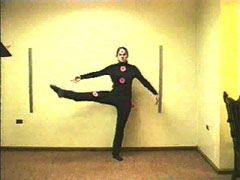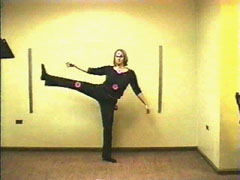|
|
|
|
See video (requires Netscape 3.0 and Quicktime 2.5) | |
INTRODUCTION
A dancer's ability to maintain balance while performing different actions allows her to execute moves gracefully and easily. This grace and ease is not so apparent when observing a person without dance training who performs the same movement. The reason for this obvious difference is balance. During practice a dancer may use a bar for balance, but during a performance, a dancer is expected to perform every movement without support. Balance is a "functional motor skill that can adapt with training and experience" (Horak et al. 1997). From the beginning of their training, dancers are taught to maintain their balance without support so they are well-prepared during performances.
One movement that dancers often perform is a kick to the side. In our study, the dancer faces forward in first position. In turn-out, the dancer will kick her leg to the side (en battement) while keeping her leg as straight as possible. The question that we are most interested in is, how does the body of an untrained person compensate for balance when performing a large movement such as the side kick as compared to a trained dancer? The purpose of this study was to determine how a non-dancer's body compensates for a shift in center of mass during a large movement as compared to a trained dancer's compensation. To accomplish this comparison, the body segments of the trunk and the thigh were studied as well as the changes in joint angle for the hip. We hypothesize that the non-dancer would have a greater movement of the torso to compensate for the movement of the leg.

